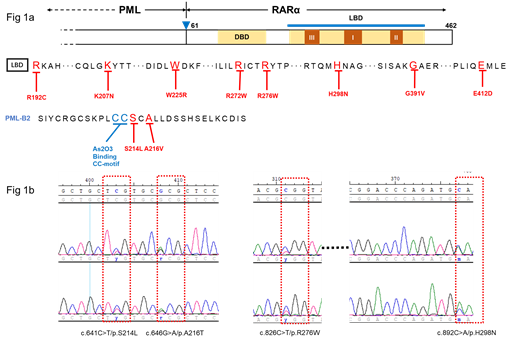Abstract
The clinical manifestations, management, and prognosis of acute promyelocytic leukemia (APL) are distinctive in acute myeloid leukemia (AML). Administration of all-trans retinoic acid (ATRA) and arsenic agents have greatly improved the outcome of APL from the most lethal to the most curable subtype AML. Unfortunately, relapse is still observed. And in the case of combined medication with ATRA and arsenic, the resistance mutation spectrum of PML-RARA is far from being revealed. We retrospectively analyzed 40 APL patients that admitted to our hospital from Jan. 2013 to Jul. 2020. There were 21 males and 19 females, aged 6-65 years (median age 31.5), and follow-up time was 3-210 months (median time 58.85 months).
There were 3 cases that developed secondary tumors, although APL remission has been achieved. One developed refractory AML with KMT2A-MLLT3 fusion during the consolidation treatment one year after the diagnosis of APL. One case relapsed with APL 5 years after the initial diagnosis, and she developed refractory AML with RUNX1-MECOM fusion 3.5 years more after enduring multiple relapses and treatment courses. Another case developed AML-M2 3.5 years after the initial diagnosis of APL, and achieved sustained remission again through allogeneic hematopoietic stem cell transplantation (allo-HSCT).
A total of 8 cases came to our hospital at the initial onset of APL, and 1 came during remission. All these cases got sustained remission through combined triple therapy (ATRA, arsenic, and chemotherapy), with the follow-up time of 3 to 37 months (median 20.5 months). No PML-RARA resistant mutation was detected in these 9 cases.
A total of 28 cases came to our hospital after APL relapse. The time from APL onset to the first relapse was 9-189 months (median 34 months). PML-RARA resistance mutations were detected in 9 cases, including 8 cases that carry single RARA mutations each, and 1 case that relapsed with multiple extramedullary infiltrations carry quadruple mutations (PML S214L-A216T and RARA R276W-H298N) (Figure 1a and b). A total of 4 cases underwent allo-HSCT after APL relapse. One of them relapsed 6 months after allo-HSCT, and the other 3 got sustained remission with the follow-up time of 47, 39, and 52 months, respectively.
There were 2 cases relapsed after maintaining sustained remission for more than 5 years. One was a 58-year-old male who achieved sustained remission after 2.5 years of combined triple therapy. However, APL recurred 16 years after the primary diagnosis. He achieved remission again and now underwent the consolidation course of combined triple therapy. Another was a 23-year-old male who achieved sustained remission after combined arsenic and chemotherapy, but APL relapsed 75 months after the primary diagnosis. He was resistant to combined triple therapy and achieved remission through allo-HSCT. We failed to retrieve archived specimens at the first onset of APL for genomic variation comparison with the second onset. Therefore, we could not determine whether these two cases were relapsed from the original APL or developed another APL.
Although we have achieved a high remission rate and long-term survival for APL through combined triple therapy, relapse and secondary tumors still occur in some cases. Especially for cases that endure heavy treatment, genomic toxicity may promote the oncogenesis of secondary tumors. Also, APL may recur over 5 years after the primary diagnosis and sustained remission. Whether there were inherited predisposing factors in these cases is worthy of further investigation.
The incidence of PML and RARA resistant mutations in cases resistance for ATRA and arsenic is not very high. This may be related to the combination use of chemotherapeutic drugs and suggests underlying resistance mechanisms. Although both ATRA and arsenic were used in most cases, the incidence of ATRA resistance mutations is significantly higher than that of arsenic, which might attribute to the sparse interaction sites of arsenic and PML.
A better combination strategy of arsenic, ATRA, with or without chemotherapy is worthy of further investigation to reduce the incidence of secondary tumors and relapse. Adhering to a systematically planed treatment course is essential for acquiring rapid remission and reduction of relapse. Treatment compliance should be paid attention to guaranteed, especially during the oral administration courses outside the hospital.
No relevant conflicts of interest to declare.


This feature is available to Subscribers Only
Sign In or Create an Account Close Modal